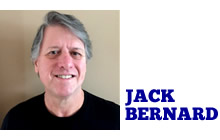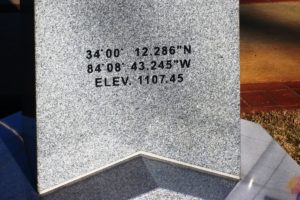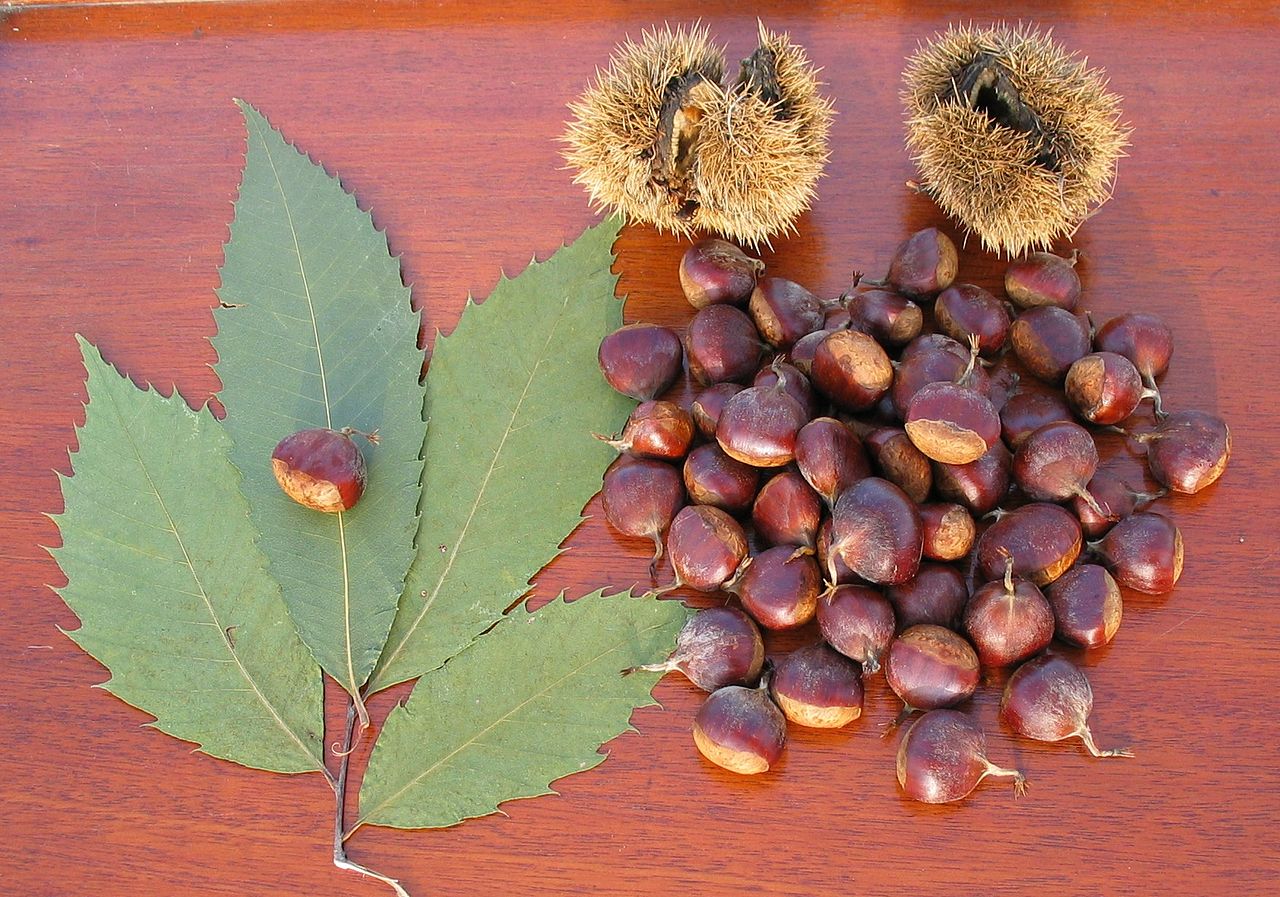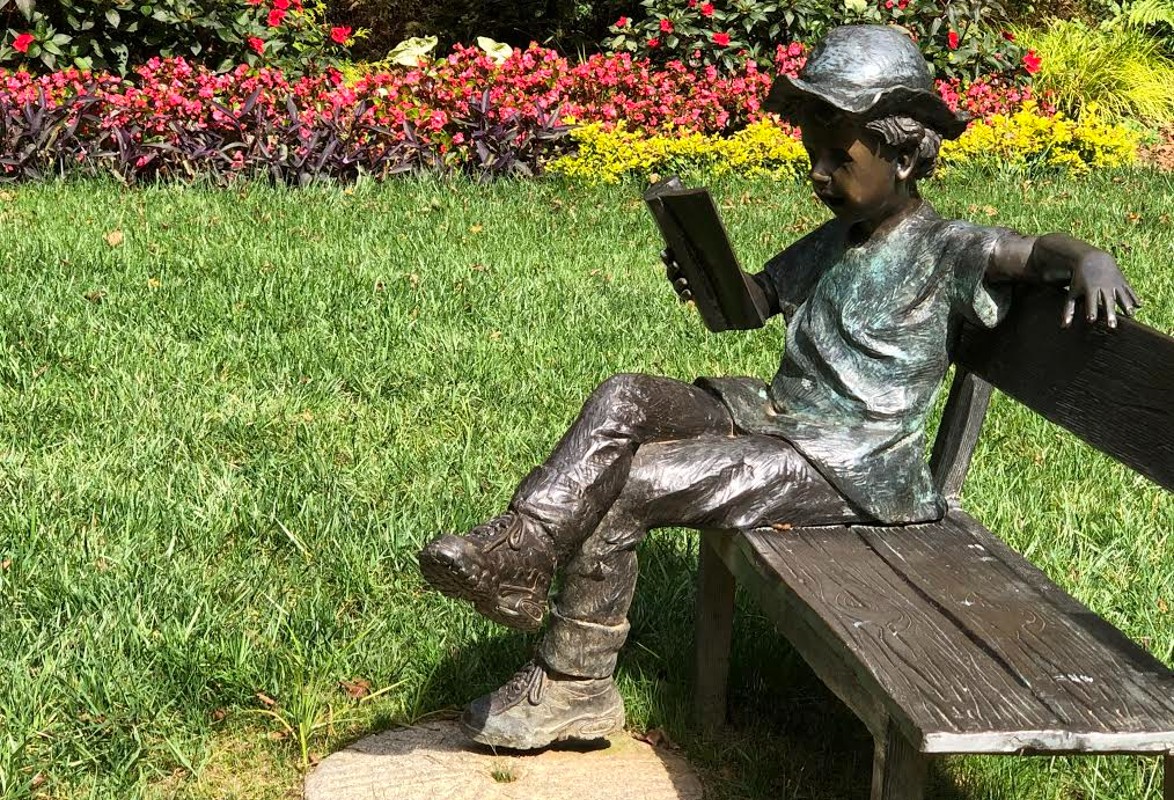GwinnettForum | Number 21.87 | Nov. 9, 2021
LOOK HOW the Eastern Continental Divide marker in Duluth sits in relation to the Duluth City Hall. This long-lens photograph makes the obelisk and the City Hall seem close together, though they are about two blocks apart. The photo was made by Stewart Woodard of Lawrenceville.
TODAY’S FOCUS: Here’s one view on legislature’s attempted redistricting plan
EEB PERSPECTIVE: Braves’ World Series memorabilia and other items
ANOTHER VIEW: What can be done to increase vaccination rates?
SPOTLIGHT: E.R. Snell Contractor, Inc.
FEEDBACK: Send us your thoughts
UPCOMING: Retired Maj. Gen. Ronald Johnson to be Veteran’s Day speaker
NOTABLE: Rehab of home in Suwanee wins national homebuilding award
RECOMMENDED: A Short History of Myth by Karen Armstrong
GEORGIA TIDBIT: Chestnut trees once composed one quarter of all Appalachian forest
MYSTERY PHOTO: Statue of child reading a book is today’s Mystery Photo
CALENDAR: Bid on 100 original paintings, all 12×12 inches, at Norcross Studio and Gallery
One view on legislature’s attempted redistricting plan
(Editor’s note: the current work by the Georgia Legislature to redraw the state’s political lines after the 2020 Census now is underway. This is a complicated and continually changing work. This week we got this message from a Gwinnett senator, explaining her views of the current work. We have so far no response from the Gwinnett Republican contingent on redistricting. –eeb)
By Nikki Merritt
Senator, Georgia District 9
ATLANTA, Ga. | We are one week into the Special Session on redistricting and I am happy to be back under the Gold Dome. It has been a contentious week as we work through various maps being proposed.
Our caucus has proposed a map which we feel is fair and reflects the will of the voters along with Georgia’s diverse population. Unfortunately, it appears that Republicans are intent on ramming through their own proposal that was released the night before special session began, which also coincided with Election Day and a World Series game, apparently to avoid public attention.
Georgians are demanding fair maps that reflect our state’s diversity and political reality. The GOP’s proposed map fails on both fronts. A non-partisan analysis by the Princeton Gerrymandering Project gave the map an overall grade of “F” along with a grade of “F” for partisan fairness.
 Georgia is one of the most diverse states in the country, and likely already a majority-minority state. (As of April 2020, Georgia’s population was 50.1 percent non-Hispanic white). This Republican map contains only 14 districts in which Black voters are a majority of the voting age population and only 20 districts in which minorities are a majority of the voting age population.
Georgia is one of the most diverse states in the country, and likely already a majority-minority state. (As of April 2020, Georgia’s population was 50.1 percent non-Hispanic white). This Republican map contains only 14 districts in which Black voters are a majority of the voting age population and only 20 districts in which minorities are a majority of the voting age population.
This map reduces the Black voting age population of the proposed 17th district by 10 percent – eliminating the ability of Black voters to elect a candidate of choice. Instead of decreasing the number of Black voters in the 17th, it can easily be drawn as a compact majority Black district as demonstrated in the Georgia Senate Democratic caucus plan.
It targets Senator Dr. Michelle Au, the only Asian-American Woman in the Senate, by reducing the minority voting age population of District 48 by 15 percent. In doing so, it splits up clear communities of interest in the existing district. Senator Au has been on the frontlines of the Covid pandemic, both locally and nationally. Her experience in public health and consistent ability to work across the aisle proves how essential she is to our Georgia Senate.
As for my own District 9, we’ve experienced huge population growth with over 210,000 people currently. Although we love that so many have chosen to make their home here, under redistricting guidelines, we have to reduce our size by roughly 18,000 people to adjust for the growth. What this means for District 9 is a reduction from five to three cities comprised of only Grayson, Lawrenceville and Lilburn.
- Have a comment? Send to: elliott@brack.net
Braves’ World Series memorabilia and other items
By Elliott Brack
Editor and Publisher, GwinnettForum
NOV. 9, 2021 | Georgians are now learning what it means for your sports team to gain national honor, like the Braves winning a World Series. Your local newspapers are flooded with offers for you to buy memorabilia of the occasion.
![]() Newspapers had several advertisements from The Bradford Exchange of Niles, Ill. for a replica of the World Series trophy, and commemorative watches, bracelets, and other trinkets, with the Braves’ logo somewhere on it. Recognize that these mementos were priced so your pocketbook would certainly feel it.
Newspapers had several advertisements from The Bradford Exchange of Niles, Ill. for a replica of the World Series trophy, and commemorative watches, bracelets, and other trinkets, with the Braves’ logo somewhere on it. Recognize that these mementos were priced so your pocketbook would certainly feel it.
Not to be outdone, we soon found that The Atlanta Journal-Constitution got into the act by offering 15 different framed pages of its newspaper with recent photos of the World Series victory. They, too, were handsomely priced, from $84.50 to $144.50. We bet there’s also a shipping and handling charge. ‘Course, you could save money by framing your own newspaper page. We have a framed “It’s Atlanta” page from the Olympics time on our wall.
The new E-Scooters seem to draw fire wherever they crop up. The Jekyll Island Authority Board recently voted to prohibit the rental of E-Scooters on the island. If you already own an E-Scooter, you can use it on the island. What the Authority was banning was their rental of the scooters, citing safety and traffic management concerns on the island’s many trails.
 Top wine-producing states: What is the third largest wine producing state in the nation? It might surprise you.
Top wine-producing states: What is the third largest wine producing state in the nation? It might surprise you.
California, of course, tops the winemaking list, with 686 million gallons, followed by the State of Washington. Washington recently outranked Oregon, which is now fifth, after Pennsylvania.
But then the third largest producer of wine? Believe it or not, New York State? They produce a lot of wine up there, 27.9 million gallons.
Georgia ranks 27th, producing 276,144 gallons. (That level of production in Georgia somewhat surprised me.) All these figures from the source Wine of the United States as of 2020.
The author Judy Budnitz was born in Atlanta on April 24,1973. Her 1998 debut book, Flying Leap, was published when she was only 24. Budnitz’s stories have been described as “modern fables or fairy tales” in the vein of Franz Kafka. Her characters are ordinary people placed in extraordinary circumstances that stretch the bounds of reality. Her most recent collection is Nice Big American Baby, published in 2005.
Classical music lovers know that Ludwig Beethoven composed nine symphonies, and we like every one of them. The conductor Hans von Bülow was moved in 1877 to call the Johannes Brahms Symphony No. 1 “Beethoven’s Tenth” (composed in 1876) because he perceived similarities between the work and various compositions of Beethoven. We happened to hear that Brahms Symphony the other day, and yes, it sounded very much like music Beethoven would have composed. Not that I am an expert; I just love that full-orchestra classical sound. What’s your favorite classical piece or conductor?
Sports writing can, at times, be very good and descriptive, but there can be an alternative. A football player’s quote this Monday: “When you find a way to get the job done, you’re a team that finds ways to get the job done.” Why newspaperman Steve Hummer used this quote is over our head.
- Have a comment? Send to: elliott@brack.net
What can be done to increase vaccination rates?
(Editor’s Note: There’s evidence that anti-vax people are in great numbers all over the world. In Italy recently, a story told of a large cadre of people in the city of Trieste resisting vaccinations. Here’s more on the subject.—eeb)
By Jack Bernard, contributing columnist
PEACHTREE CITY, Ga. | I receive both right and left-of-center newsletters. They vary in quality. One of the best conservative on-line newsletters is the Daily Signal, by the respected Heritage Foundation. One particularly good piece concerned masking. It was well written, done by a data scientist (Kevin Dayaratna) and scientifically based, as opposed to the many emotionally charged commentaries issued by the right.
 Although I disagreed with Dayaratna’s assumption that mandatory masking is unnecessary, I did concur in his conclusion that there is a much better way to prevent the spread of the virus, that is, by vaccinations.
Although I disagreed with Dayaratna’s assumption that mandatory masking is unnecessary, I did concur in his conclusion that there is a much better way to prevent the spread of the virus, that is, by vaccinations.
But, one course of action should not exclude the other.
JAMA (the Journal of the American Medical Association) is one of the most revered sources of medical information both for the USA and the world. One piece that it published studied the issue of masking. It concluded that use of masks “substantially reduces transmission” of Covid in two ways. First, masks block “exhalation of virus-containing droplets into the air” and secondly, “masks protect uninfected wearers.” The authors cite a number of studies to drive home their point.Masking has limited effectiveness, but it is clearly one proven method to reduce the spread of Covid-19, although vaccinations are clearly a better method.
 The Daily Signal author does a good job of proving the case for vaccinations. Per his analysis, the odds of unvaccinated seniors 65+ dying of Covid-19 are 1 in 8 if they catch the virus. However, the odds rise substantially to 1 in 25,000 for vaccinated seniors getting Covid.
The Daily Signal author does a good job of proving the case for vaccinations. Per his analysis, the odds of unvaccinated seniors 65+ dying of Covid-19 are 1 in 8 if they catch the virus. However, the odds rise substantially to 1 in 25,000 for vaccinated seniors getting Covid.
However, Dayaratna also states that in his opinion “the best ways to encourage the vaccine hesitant to reconsider is not mandates, but rather to equip them with good statistical analysis” working with their physicians. At this point, the analysis leaves the realm of science and moves into the political sphere.
Vaccinations and masks should not be political issues, but thanks to former President Trump they clearly are. If Trump supporters were going to get their vaccinations based on the science, they would have already spoken to their MDs and gotten their shots long ago. They have made the conscious decision not to do so, as discovered by a recent Fox News poll. (In fact, some 54 percent of them say they have gotten vaccinated…whereas another 32 percent of Trump voters have already made the decision that they won’t ever.
The only way that this attitude will change is for Trump to say loudly and often that his supporters must get vaccinated. And that will not happen, especially after Trump got booed by his own people the one time he mentioned it at a rally.)
So, what can be done to increase vaccination rates? Mandates and monetary incentives appear to work best. As I have long advocated, the Federal government must mandate shots for all of its employees. State and local governments as well. In Georgia, vaccinations for many diseases are already required to attend school. Just add the Covid-19 shot to the list.
The bottom line is that one way or the other every American will eventually either get vaccinated or get some Covid-19 variant. Government and the private sector must both do their part to ensure that all that can be done is done to ensure the maximum number of Americans get the shots. The alternative is increased sickness and death.
- Have a comment? Send to: elliott@brack.net
E.R. Snell Contractor, Inc.
T he public spiritedness of our sponsors allows us to bring GwinnettForum.com to you at no cost to readers. Today’s sponsor is E.R. Snell Contractor, Inc. of Snellville. Founded in the 1920s, ERS was built on Christian beliefs with honesty and integrity leading the way. Specializing in roads, bridges and culverts, its goal is to build a safe and modern highway system while preserving our natural environment. Through quality production and high safety standards, it strives to be the best contractor possible, while continuing to be a positive influence on its employees and the community.
he public spiritedness of our sponsors allows us to bring GwinnettForum.com to you at no cost to readers. Today’s sponsor is E.R. Snell Contractor, Inc. of Snellville. Founded in the 1920s, ERS was built on Christian beliefs with honesty and integrity leading the way. Specializing in roads, bridges and culverts, its goal is to build a safe and modern highway system while preserving our natural environment. Through quality production and high safety standards, it strives to be the best contractor possible, while continuing to be a positive influence on its employees and the community.
- Visit online at www.ersnell.com.
- For a list of other sponsors of this forum, click here.
Send us your thoughts
We encourage you to send us your letters and thoughts on issues raised in GwinnettForum. Please limit comments to 300 words, and include your hometown. The views of letters are the opinion of the contributor. We reserve the right to edit for clarity and length. Send feedback and letters to: elliott@brack.net.
Johnson, retired general, to be Veteran’s Day speaker
Gwinnett County will recognize the men and women who served in the armed forces during its annual Veterans Day Ceremony at the Gwinnett Fallen Heroes Memorial on the grounds of the Gwinnett Justice and Administration Center, 75 Langley Drive, in Lawrenceville at 11:11 a.m. Thursday, November 11.
The ceremony will be held in-person with an option for residents to tune in live via the County’s Facebook page @GwinnettGov.
Veterans who served honorably are encouraged to participate and be honored for their service and sacrifice.
The speaker for the occasion will be retired Maj. Gen. Ronald L. Johnson, a professor of Industrial and Systems Engineering at Georgia Tech.Johnson served as the deputy commanding general and deputy chief of engineers, the second highest-ranking senior engineer staff officer for the U.S. Army Corps of Engineers. Johnson is the former Managing Director of the Tennenbaum Institute of Enterprise Transformation at Georgia Tech.
Rehab of Suwanee home wins national homebuilding award
The winner of the 2021 “Best in American Living” award of the National Association of Homebuilders has been won by a Pendergrass company headed by the son of a Gwinnett County resident.
Travis Camerio’s project in Suwanee, Perez Project in Remodeling, Category 46: Specialty Project, has won this award. The Perez project consisted of remodeling a home of a person who had a traumatic brain injury. The company had to essentially build a custom home and rehabilitation facility inside a home that was already a custom home. The planning and construction took almost 11 months. An award ceremony for the award will be held during the International Builders’ Show (IBS) in Orlando, Fla. on February 9, 2022.
Camerio’s company had previously won two Gold OBIE awards from the Atlanta Homebuilders Association for this project. OBIE Awards began in 1980 to recognize outstanding achievement in the home building industry. The OBIE Awards are considered a premier award in the Atlanta home building industry.
Camerio has previously served for four years as chairman of the Gwinnett County Chapter for the Greater Atlanta Home Builders Association. Camerio is the son of Mr. and Mrs. Lou Camerio of Lilburn.
Brenau U. president on panel tonight being zoomed
 Brenau University President Anne Skleder will participate in an upcoming expert panel that aims to take a broader perspective on higher education today. She will be one of three presidents of women’s colleges who will talk about the importance of college and how colleges are adapting.
Brenau University President Anne Skleder will participate in an upcoming expert panel that aims to take a broader perspective on higher education today. She will be one of three presidents of women’s colleges who will talk about the importance of college and how colleges are adapting.
“The Future of Higher Education: A Case Study with Women’s College Presidents,” will be live-streamed via Zoom beginning at 7 p.m. on Tuesday, Nov. 9. The free event is hosted by the Women’s College Coalition as part of Collegewise’s “College Nights – Admissions Expert Series.” The five-week series provides prospective college students with advice from different admission experts.
Presidents Anne Skleder of Brenau University, Carine Feyten of Texas Woman’s University, and Mary Hinton of Hollins University will discuss the purpose of college, how colleges are creatively adapting, and the crucial role that women’s colleges play in the higher-education landscape. The three presidents will share their wisdom and perspective for students, parents, and educators alike – all from the presidential vantage point. Registration is available online at go.collegewise.com/college-nights.
- Have a comment? Send to: elliott@brack.net
A Short History of Myth by Karen Armstrong
![]() From Karen J. Harris, Stone Mountain: The author begins by defining “myth” as a way early populations discerned meaning from the world around them through carvings, pictures and artifacts used in rituals. She explores these time periods: the Paleolithic Period: the Mythology of the Hunters (c. 20,000-8,000 BCE); the Neolithic Period: The Mythology of the Farmers (c . 8,000 to 4,000 BCE); the Early Civilizations: (c. 4,000 to 800 BCE); the Axial Age (c. 800 to 200 BCE); the Post Axial Age (c. 200 BCE t0 1,500CE) and finally, the Great Western Transformation (c. 1,500 to 2,000). Great changes begin during the Axial Age and continue through the Great Western Transformation. With each generation, there are huge improvements leading to an agrarian culture that moves to urban cultures that begin looking more to science as the sole avenue for seeking truth. This book is an edifying read for storytellers and readers of all genres and disciplines.
From Karen J. Harris, Stone Mountain: The author begins by defining “myth” as a way early populations discerned meaning from the world around them through carvings, pictures and artifacts used in rituals. She explores these time periods: the Paleolithic Period: the Mythology of the Hunters (c. 20,000-8,000 BCE); the Neolithic Period: The Mythology of the Farmers (c . 8,000 to 4,000 BCE); the Early Civilizations: (c. 4,000 to 800 BCE); the Axial Age (c. 800 to 200 BCE); the Post Axial Age (c. 200 BCE t0 1,500CE) and finally, the Great Western Transformation (c. 1,500 to 2,000). Great changes begin during the Axial Age and continue through the Great Western Transformation. With each generation, there are huge improvements leading to an agrarian culture that moves to urban cultures that begin looking more to science as the sole avenue for seeking truth. This book is an edifying read for storytellers and readers of all genres and disciplines.
An invitation: what books, restaurants, movies or web sites have you enjoyed recently? Send us your recent selection, along with a short paragraph (150 words) as to why you liked this, plus what you plan to visit or read next. Send to: elliott@brack.net
Chestnut trees once composed 1/4 of Appalachian forest
Until the beginning of the 20th century, the American chestnut (Castanea dentata [Marshall] Borkh) was one of the most prevalent and valuable trees in the eastern forests of the United States. The chestnut blight fungus (Cryphonectria parasitica), accidentally introduced around 1900, killed most of the mature trees in the natural range of the species, and today the species exists mainly as an understory shrub. Efforts currently underway in Georgia and other states, however, may eventually result in the restoration of American chestnut to eastern forests.
Before 1900 American chestnut was said to have composed up to one-quarter of the standing trees of the Appalachian forest, including the north Georgia mountains, and in Georgia its range also extended into the upper Piedmont. The trees were especially dominant on higher mountain ridges and flats. They grew very rapidly to heights of up to 100 feet, with trunks more than 6 feet in diameter. Chestnut was more useful than any hardwood in America, providing timber for houses, barns, and fences; tannin for the leather industry; and nuts for people and wildlife. The wood was straight-grained and easy to split and work with hand tools. The heartwood of mature trees was very high in tannin content, which made the wood so decay-resistant that chestnut timbers in structures built more than a hundred years ago are still as sound now as they were when the structures were erected. Abundant nut crops were produced almost every year and provided a major source of food for wild turkey, deer, bear, and smaller mammals. Those who have tasted American chestnuts say that they are sweeter than their Asian and European counterparts.
The first documentation of chestnut blight in North America was in 1904, when a forester noticed that the American chestnut trees growing at the Bronx Zoo in New York City were dying. A fungus, designated at the time as Endothia parasitica but since reclassified as C. parasitica, was soon identified as the cause of the disease. It is now generally agreed that the fungus entered the United States on Japanese chestnut stock imported as orchard trees in the late 1800s. Since Chinese and Japanese chestnut trees coevolved with the blight fungus, they are much more resistant to it than the American chestnut is. The fungus produces two kinds of spores, one of which is spread by wind and the other by rain, insects, and birds. These spores spread the infection south from New York at the rate of about 200 miles every ten years, wiping out almost every mature chestnut tree in the natural range of the species.
The blight reached Georgia in the 1940s. Wounds in the bark allow fungal mycelia from germinated spores to penetrate living cells quickly. The mycelia fan out within the inner bark of the tree, killing the food-conducting tissue (phloem) and the layer of dividing cells (cambium) that gives rise to the phloem and the water-conducting cells (xylem), and forming a characteristic canker on the stem. When the phloem tissues die in a complete ring around the stem (girdling), the tree can no longer transport water to its leaves and rapidly dies. American chestnut can still be found in eastern forests today, because it continues to resprout from surviving root systems in the soil. However, the tree rarely reaches thirty feet or produces nuts before it is attacked and killed by the fungus, which also infects the Allegheny chinkapin (Castanea pumila) and some species of oaks.
(To be continued)
Statue of child reading a book is today’s Mystery Photo
Today’s Mystery Photo is a statue of a child sitting on a bench, reading a book. But it’s not just any child, and it’s not just any location. Figure all this out and tell us about this mystery, by sending your photo to elliottt@brack.net, and include your hometown.
 Who would have thought that the Eastern Continental Divide marker in Duluth would have produced considerable consternation as the Mystery Photo? It proved most difficult for some, who have yet to get it. The photo came from Miriam Machida of Watkinsville, who herself guessed it right, even though she didn’t remember sending to us the photo a long time ago.
Who would have thought that the Eastern Continental Divide marker in Duluth would have produced considerable consternation as the Mystery Photo? It proved most difficult for some, who have yet to get it. The photo came from Miriam Machida of Watkinsville, who herself guessed it right, even though she didn’t remember sending to us the photo a long time ago.
Among those recognizing the one clue on the statue was Rich Hammond of Lawrenceville; Kay Montgomery of Duluth; Stewart Woodard of Lawrenceville; Channing Haskell of Peachtree Corners; Susan McBrayer of Sugar Hill; Virginia Klaer of Duluth; Chuck Cimarik, Peachtree Corners, who said:” Personally I like the one in Norcross better. It has more character…”
 Allan Peel of San Antonio, Tex. wrote: “Today’s mystery photo is of the Eastern Continental Divide Monument, located at the Town Green in Duluth. It is a 9-foot tall, 18-inch square, 3,600 pound obelisk made out of native Georgia granite with a dividing line down its middle and helpful arrows on either side. Water on one side flows to the Atlantic Ocean; on the other it flows to the Gulf of Mexico.”
Allan Peel of San Antonio, Tex. wrote: “Today’s mystery photo is of the Eastern Continental Divide Monument, located at the Town Green in Duluth. It is a 9-foot tall, 18-inch square, 3,600 pound obelisk made out of native Georgia granite with a dividing line down its middle and helpful arrows on either side. Water on one side flows to the Atlantic Ocean; on the other it flows to the Gulf of Mexico.”
George Graf of Palmyra, Va. located the statue photo, too. He also wrote: “Did you know that the antipodal city to Duluth is Gnarabup, Australia. This means that the farthest city from Duluth is Gnarabup.The exact Antipodal point of Duluth (Opposite side in the world) is in the ocean waters off the shore of Australia, and the nearest land-based city is Gnarabup.The distance from Duluth to Gnarabup is about 18,000 kilometers. A direct flight would take around 20 hours, but there aren’t commercial routes between these cities. Maybe Duluth could become twin sister cities with Gnarabup. I like the sound of it.”
Tom Fort, Snellville, came up with a distinctive accounting to solve the mystery, though we don’t understand his last sentence: “A retired detective, a direct descendant of Sherlock Holmes, is asked to solve a mystery—a missing historical artifact from the early days of the USA. He finds a map. It is of the Eastern Continental Divide, with the early colonies to the east of the line. The first clue is in Florida near Lake Okeechobee. He is led through a scavenger hunt-like series of clues, all along the Divide, north through Florida and Georgia – with a few in modern Gwinnett: Jimmy Carter Boulevard, downtown Norcross, Peachtree Corners. One of them happens to be on West Lawrenceville Street in Duluth, near the Maple Street Biscuit Co., across the street from the marker for the Divide. The rest of the clues are in North Carolina, Virginia. West Virginia, Maryland and Pennsylvania. He finally solves the case in Ulysses Township, Potter County, Penn.”
![]() Silent Auction at the Norcross Gallery and Studios is now underway. Bid on 100 original paintings, all 12×12 inches, during this annual FUNdraiser. You may view these paintings in many styles and genres through December 4 at the gallery, at 116 Carlyle Street in Norcross.
Silent Auction at the Norcross Gallery and Studios is now underway. Bid on 100 original paintings, all 12×12 inches, during this annual FUNdraiser. You may view these paintings in many styles and genres through December 4 at the gallery, at 116 Carlyle Street in Norcross.
Gwinnett Place Mall’s future is the subject of two meetings set soon. J You can join a conversation in your language of choice on November 10 from 6 to 8 p.m. at Berkmar High School, located at 405 Pleasant Hill Road in Lilburn. To register, visit GCGA.us/JoinAConversation.
Groundbreaking of Gwinnett’s Eastern Regional Infrastructure project will be Tuesday, November 9, at 10 a.m. at 1762 Harbins Road in Dacula. Because of the nature and location of this event, attendees are advised to wear comfortable, closed-toe shoes. More details: GwinnettERI.com.
Veterans Day Ceremony will be November 11 at 11 a.m. at the Fallen Heroes Memorial at the Gwinnett Justice and Administration Center. 75 Langley Drive in Lawrenceville. The keynote speaker will be Army Maj. Gen. Ronald L. Johnson (retired), a professor of Industrial and Systems Engineering at Georgia Tech.
Mountain Park Community Pop-up meeting will be Saturday November 13, from 1-4 p.m. at JB Williams Park, 4935 Five Forks Trickum Road. Residents of this area are invited to learn about services provided by the Gwinnett Planning and Development and share their vision for the future. For more information, contact Nargis Fountaine at 678-518-5705 or contact PamDOutreach@Gwinnett County.com.
GwinnettForum is provided to you at no charge every Tuesday and Friday.
Meet our team
- Editor and publisher: Elliott Brack, 770-840-1003
- Managing editor: Betsy Brack
- Roving photographer: Frank Sharp
- Contributing columnist: Jack Bernard
- Contributing columnist: George Wilson
More
- Mailing address: P.O. Box 1365, Norcross, Ga. 30091
- Work with us: If you would like to serve as an underwriter, click here to learn more.
Subscriptions to GwinnettForum are free.
- Click to subscribe.
- Unsubscribe. We hope you’ll keep receiving the great news and information from GwinnettForum, but if you need to unsubscribe, go to this page and unsubscribe in the appropriate box.
© 2021, Gwinnett Forum.com. Gwinnett Forum is an online community commentary for exploring pragmatic and sensible social, political and economic approaches to improve life in Gwinnett County, Ga. USA.















Follow Us